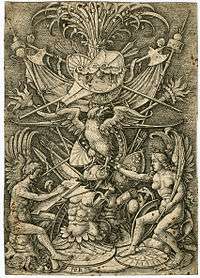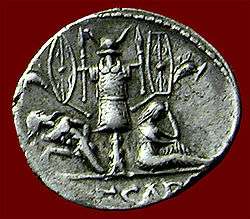Trophy of arms



An antique trophy of arms is an artistically assembled display of weaponry, often captured from a defeated enemy, designed for the purpose of triumphalist display by a victor or as a show of military prowess by a monarch.
Origins
The practice was used in the classical age by the Greeks and Romans. Homer's Iliad relates the practice of warriors in the Trojan War removing the armour and weapons of a killed opponent in order to make an offering to the gods. This was contrasted to mere booty. Trophies of arms were commonly depicted on Greek and Roman coins. In England a tradition of making trophies of arms and armour, designed to display British military prowess, was established in the armoury of the Tower of London from the late 17th century.[1] In about 1700 John Harris created an impressive display in the Grand Storehouse which included a serpent and a seven-headed Hydra, together with a variety of weapons including muskets, pistols and swords. The antiquarian William Maitland described it as a sight "no one ever beheld without astonishment...not to be matched perhaps in the world".[2]
Constituent elements
Elements commonly depicted within antique trophies of arms include:
- breastplates
- spears
- halberds
- bows
- arrows
- quivers
- lit torches
- swords
- cannon and balls
- captured military standards
- clubs
References
External links
![]() Media related to Trophy of arms (antique) at Wikimedia Commons
Media related to Trophy of arms (antique) at Wikimedia Commons